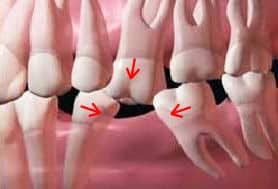
Losing Teeth Causes Bone Loss and Bite Collapse
Have you ever wondered why people end up needing to remove all their teeth and replace them with implants? You may be wondering if you really need to replace a missing tooth. And what happens if a lost tooth does not get replaced with a dental implant. Losing all your teeth starts with missing one. And then it is a snowball effect. It may not bother you much to see a hole when you smile, but the benefit of replacing a tooth isn’t just about making it look better.

bad bite
Consequences of Tooth Loss
To understand the advantages of tooth replacement, it’s important to know the consequences of losing teeth. For starters missing teeth will lead to more tooth loss. And losing your back teeth will lead to losing your front teeth. So if you want to keep your smile, this article is for you. Getting teeth replaced with implants is the best move if you had to get one pulled. All of the consequences of missing teeth are not immediately obvious. This article will explain the truth about missing teeth and what happens if you do not fill missing tooth spaces with replacements.
Bone Loss is Progressive After Losing Teeth
Teeth provide support for jaw bone, lips and cheek tissue. When teeth are lost, tissue can collapse into the teeth spaces. The jaw bone maintains strength by the stimulation teeth receive through biting and chewing. When there is a missing tooth, the jaw bone in that area weakens because it doesn’t get any pressure. Weakening of the bone is a process called ‘resorption’ and osteoporosis.

dentures vs dental implants 1
Bone loss can Spread to other parts of the Jaws
Loss of bone volume in one area can spread. As the entire jaw bone declines in strength, teeth can become affected. This can increase the risk of teeth breaking, gum disease, and cavities. Loss of bone structure changes your facial appearance. The face begins to look sunken-in because the lips and cheeks have less support from teeth and jaw bone volume. The quickest way to look years older and wrinkly, is to lose jaw and facial bone. There are new natural bone regeneration techniques using platelet rich fibrin or PRF.
Missing Teeth Causes Shifting and Bite Problems
Without the support of surrounding teeth, a tooth will start to shift. This can cause misalignment of the bite and gaps in between teeth. Teeth may also start to loosen as they move out of position. This is called bite collapse and tooth splaying. When spaces open up in between teeth, food and bacteria get trapped and it causes gum disease and tooth decay. As teeth move into new positions, they meet one another differently top to bottom. This can cause bite problems, teeth clenching and grinding at night-time.
Wrinkling of Facial Skin Including Lips, Cheeks and Resting Lines
Teeth have a great influence in the way your face look. If you’ve ever seen people with an overbite and looked at their profile, you can see the overbite even when they don’t open their mouth. This is just an example of how the teeth influences what the face looks like. Missing teeth and other shifting can change the way the face looks, and the changes may not be in a way people prefer.
As people age, the facial changes are much more dramatic. Missing teeth can cause skin to sag around the mouth causing deep wrinkles. This can lead to people looking much older than they would look if they had all of their teeth.
Bite Problems can Cause Headaches and Neck Tension
Many people with missing teeth report suffering from an increase in headaches and TMJ pain. This is due to the demand placed on the existing teeth. It’s just like when you have a group of people working on a project. When there are missing people, the rest of the people in the group have to do more to get the project done. When there are missing teeth, the other teeth have to work harder to chew food until it’s ready to swallow.
Speech Problems from Tooth Loss
Missing teeth can cause speech problems. People who have missing teeth may slur their words and stutter, because the tongue isn’t working as it did when the teeth were there. Over time, the slurring may not be so obvious, but it can be quite embarrassing for people who have to speak professionally. Missing teeth can also lead to lots of extra salivary flow, slobbering and spitting.
Sinus Problems and Changes
Back, upper teeth that are missing can change the size and shape of the sinuses. This change in the sinus structure can also lead to bone atrophy in sinus spaces. A cratering effect in the sinuses can be seen along with poor sinus shape, and sinus drainage. Basically, the changes in shape in the sinus does not lead to good drainage. Similar to a grass area with a sunken-in and depressed area. Water will stand and sit in these areas. Bacteria will fester in sinus “holes” and cause bacterial congestion and sinusitis. Sinus problems can be fixed with sinus lifts and bone grafts. But the costs are high and surgery will be necessary.
So, in addition to having a “holey” smile, people who are missing teeth can suffer from jaw bone loss, misaligned teeth, facial changes, headaches, speech problems and sinus changes. All of these consequences of not replacing teeth are too serious to ignore. With this knowledge, it’s now important to know the best way to replace teeth. Research has show the the loss of just one back tooth can lead to the collapse of the entire bite and the loss of several more teeth. The best time to replace a tooth is immediately after it is lost with a dental implant.
Dentures are not a good permanent option
Dentures or partial dentures is one way to replace teeth, but not the best way. Dentures speeds up bone loss due to the pressure they place on the jaw bone. It wears the bone out, which then shrinks it much quicker than other ways to replace teeth. The rate of bone loss accelerates for those who wear dentures all the time, including overnight.
A teeth bridge is an alternative to a dental implant. It’s not the best way to replace missing teeth, though. A bridge does not provide the stimulation the jaw bone needs to maintain strength. As the jaw bone weakens, a gap can develop underneath the bridge, which can become visible when the person smiles.
If dentures or partial dentures and a bridge aren’t the best way to replace missing teeth, what is?
Dental Implants is Best Replacement Option
Dental implants are the best way to replace missing teeth. They stop bone loss in its tracks. Dental implants are supported by the jaw bone. When people chew and bite food, the implants stimulate the jaw bone just like natural teeth do, which means the jaw bone remains strong. Implants help preserve bone after tooth loss. The recovery after implant surgery does not take long or hurt too much.
Dental implants use the jaw bone as foundation and are able to support themselves in between neighboring teeth. This means that other teeth are not affected by the implant. For people who have many missing teeth, dental implants are a good way to create a full arch of replacement teeth.
The benefits of implants, especially metal-free implants are incredible. non-metal zirconia implants do not corrode, have no risk of causing allergic reactions, and are durable enough to last a lifetime. Titanium implants are metal and they are less likely to crack and break. That means not having to spend money on replacement implants. People often choose titanium dental implants because the long-term studies of success.

 (301) 421 1996
(301) 421 1996 burtonsvillesmiles@gmail.com
burtonsvillesmiles@gmail.com